#plante du jardin
Explore tagged Tumblr posts
Video
Perles du jardin par brigitte lagravaire Via Flickr : 2017-05-02-goutttes (8cn)
#mai#printemps#eau#jardin#vert#plante#pluie#macro#l'eau#Lot-et-Garonne#Aquitaine#platycodon#LCOB#BLALB#feuilles#goutte#France Sud-Ouest#20170502#plante du jardin#verdure#goutte d'eau#goutte de pluie#gouttelettes#gouttes#gouttes d'eau#TUMBLR#flickr
0 notes
Note
trick or treat! 👹
hey amy!!! RED PANDA FOR YOU 👹🐼



2 notes
·
View notes
Photo

Driveway Driveway in Nantes Design suggestions for a large farmhouse with a summertime courtyard that receives partial sun and decking.
#roquette du jardin#terrasse bois#duvaletbossennec paysagiste concepteur#plantes potagères#jardin-terrasse
0 notes
Video
youtube
FELIDAE - Le magazine félin pour l'autre
#youtube#bioparc de doué la fontaine#Dommaine des fauves#ménagerie du jardin des plantes#parc des félins#parrot world#zoo de bordeaux-pessac#zoo de champrépus#zoo de jurques#zoo de la flèche#zoo de la palmyre#zoo de vincennes#Zoo du bassin d'Arcachon#Zoo du bois d'Attilly#zooparc de beauval#ZooSafari de Thoiry
0 notes
Text
"Moi quand j'étais au collège, on avait le choix le jeudi entre aller au Jardin des plantes ou visiter le musée du Louvre. Alors je choisissais le musée du Louvre... parce qu'on revenait par la rue Saint-Denis."
Jean Yanne
Source: Régis Vidal
#short video#régis vidal#rue saint denis#paris#quotes#jean yanne#humour#funny video#illustration#fidjie fidjie
92 notes
·
View notes
Text
Les Mis Canon-era Paris Photographs: Jean Valjean and Cosette’s route to escape Javert, in Pictures!

Jean Valjean's escape through Paris is Victor Hugo's way of mourning the Paris he knew from before his exile, the Paris before the modern renovations.
Hugo wrote Les Mis from exile in Guernsey, at the same time as Paris was undergoing a series of massive renovations. The "Old City" of medieval Paris that Hugo loved was being replaced by the “New City" of Baron Haussman. The dark medieval labyrinth lit by oil lamps was being replaced by modern wide streets and standardized architecture lit by gas lamps. Victor Hugo is nostalgic for the Paris he remembers before his exile-- so Jean Valjean is able to escape Javert using things unique to the Old City. He escapes through a labyrinth of tiny medieval streets in a neighborhood Hugo claims was destroyed during the renovations; he climbs over the convent wall using the rope from an oil lamp, the very oil lamps that were being replaced by the more modern gas lanterns. The dark maze hides him from police surveillance in a way modern streets cannot.
A man named Charles Marville photographed Paris shortly before many (though not all) of the renovations occurred. In this post I'll go through all the different streets mentioned in the Valjean-Javert Paris chase chapters, and provide Marville's photographs whenever they the image has been labeled with the name of the street. Note that there may be some inaccuracies. Some street names changed over time.
Here is a map of what the chase looks like, taken from the book "Paris in the Times of Victor Hugo."
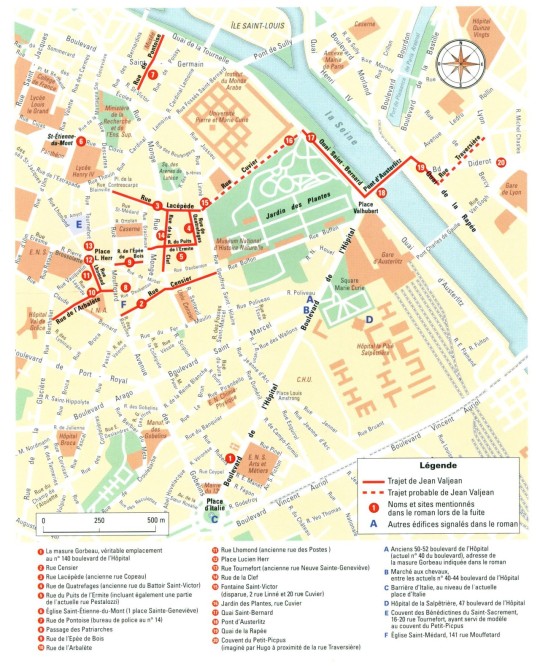
A quick overview: Jean Valjean starts in a slummy half-built suburban area. This area is highly associated with the King; the royal Jardin des Plantes is nearby, and King Louis XVIII often rides by in his carriage during the afternoons. After travelling down a bunch of streets, "zigzagging" back and forth, Jean Valjean decides to cross the Seine over the Bridge of Austerlitz (a bridge named after one of Napoleon's victories.) Then he reaches the areas of the city near the Faubourg Saint Antoine that are more associated with working class rebellion. From there he enters a dark isolated half-built medieval neighborhood near marshes and timberyards, with narrow mazey alleyways, that Hugo mostly made up. Hugo pretends this medieval neighborhood used to exist, but was destroyed like many others during the recent renovations. Now that we've gotten the overview out of the way, let's go more specific!
The chase starts out in "the old quarter of the Marche aux Chevaux." At the time, this was a less inhabited and poorer area of Paris; it's described as basically a slum. Here are some of Marville's photographs :

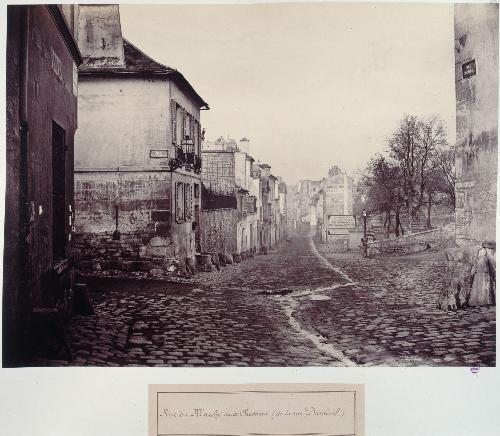
Then we're told "Jean Valjean described many and varied labyrinths in the Mouffetard quarter, which was already asleep, as though the discipline of the Middle Ages and the yoke of the curfew still existed. He combined in various manners, with cunning strategy, the Rue Censier:"
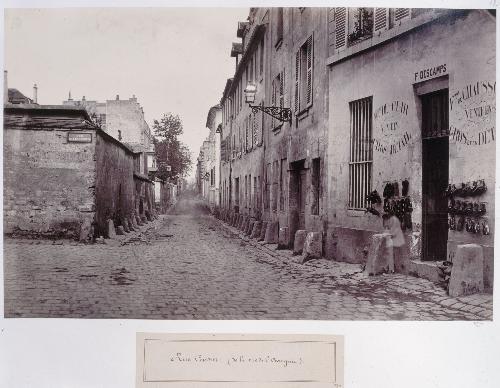
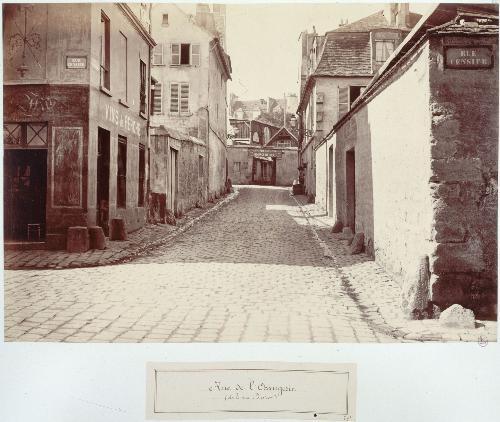


"and the Rue Copeau," (according to the map I linked earlier, the Rue Copeau is now the Rue Lacepede. Here is Marville's pic:)

"the Rue du Battoir-Saint-Victor and the Rue du Puits l’Ermite. There are lodging houses in this locality, but he did not even enter one, finding nothing which suited him. He had no doubt that if any one had chanced to be upon his track, they would have lost it."
"As eleven o’clock struck from Saint-Étienne-du-Mont:" (note: this refers to the church of Saint-Etienne)

"he was traversing the Rue de Pontoise, in front of the office of the commissary of police, situated at No. 14." (Jean Valjean sees Javert and the police following him on this street, because they're visible in the light of the lantern from the police station.)
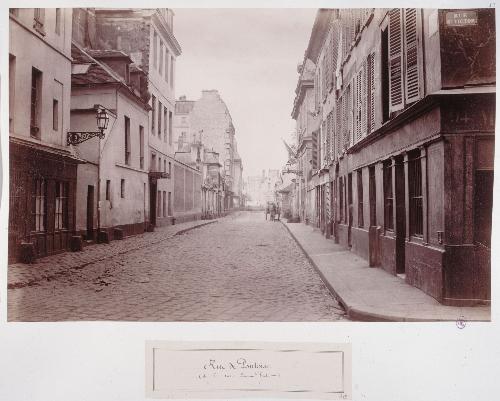
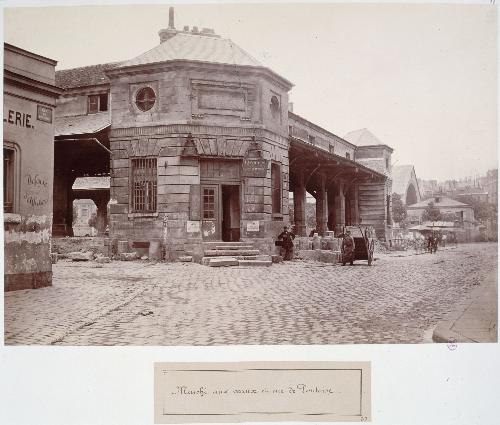
"He took a circuit, turned into the Passage des Patriarches, which was closed on account of the hour,"
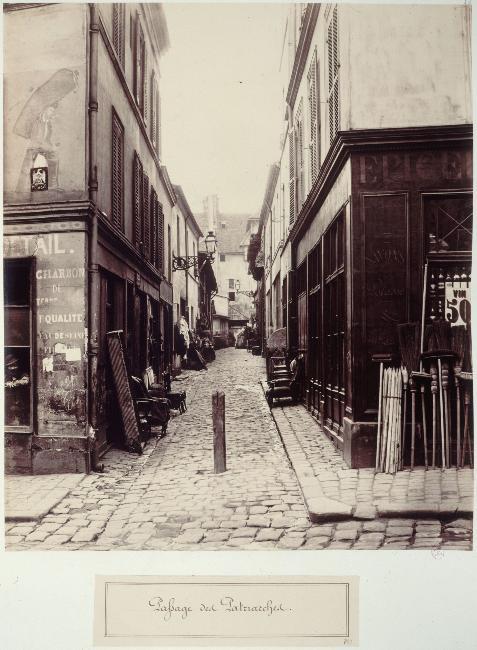
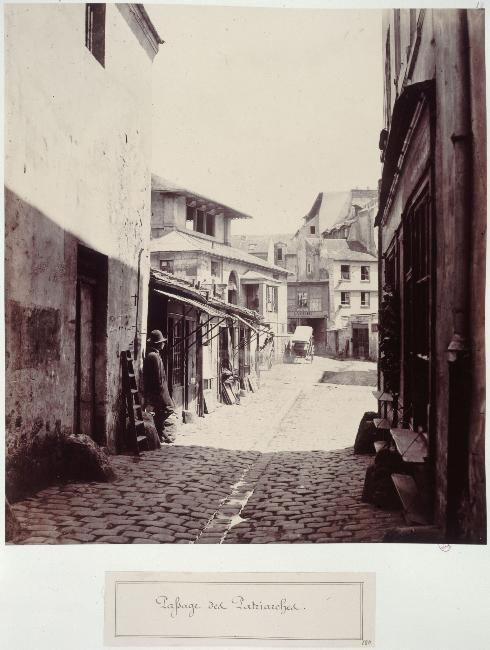
"strode along the Rue de l’Épée-de-Bois

and the Rue de l’Arbalète, and plunged into the Rue des Postes."


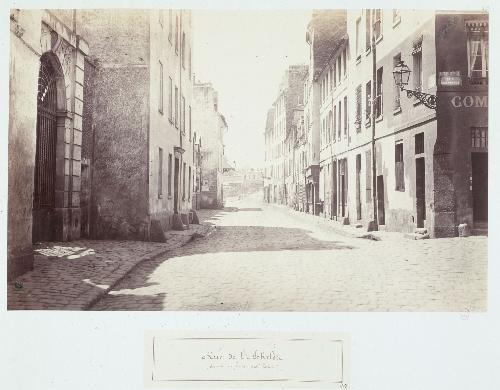
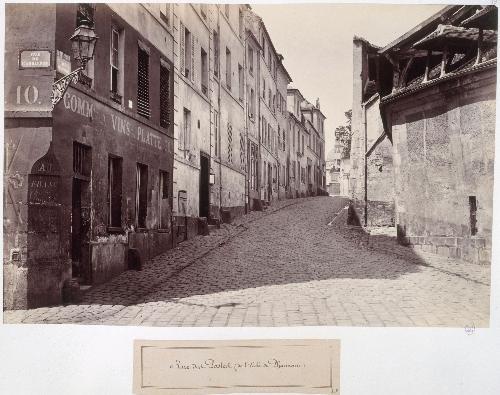
"At that time there was a square formed by the intersection of streets, where the College Rollin stands to-day, and where the Rue Neuve-Sainte-Geneviève turns off." (Note: these streets are labeled Montagne-Sainte-Geneviève, but not Neuve-Sainte-Geneviève, so they may be different streets! But I'm putting them here anyway.)
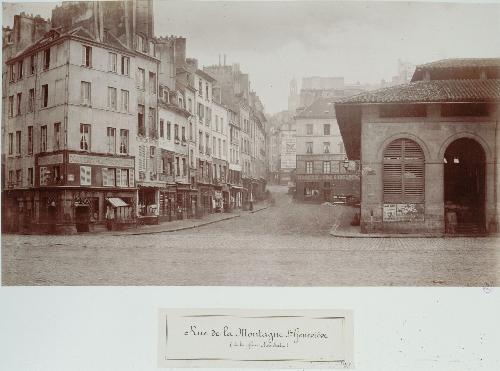
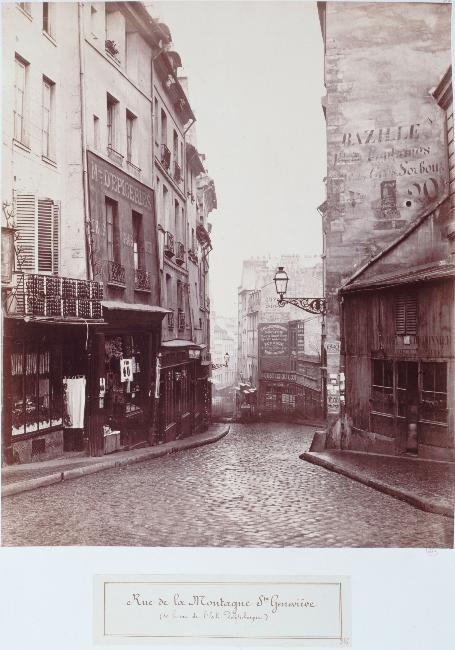

"It is understood, of course, that the Rue Neuve-Sainte-Geneviève is an old street, and that a posting-chaise does not pass through the Rue des Postes once in ten years. In the thirteenth century this Rue des Postes was inhabited by potters, and its real name is Rue des Pots." (Annotation: Hugo's bein silly and making little puns. He's snarkily pointing out the "new saint-genevieve street" is old, and the post street rarely has post-chaises/carriages go through it.) (Jean Valjean hides in the shadows and watches to see who shows up in this big square intersection of streets. In the moonlight, he recognizes Javert.) "He slipped from under the gate where he had concealed himself, and went down the Rue des Postes (which I shared a picture of previously), towards the region of the Jardin des Plantes." (Note: the Jardin des Plantes is a royal garden. Here is a modern photo from Wikipedia.)

"He left behind him the Rue de la Clef,
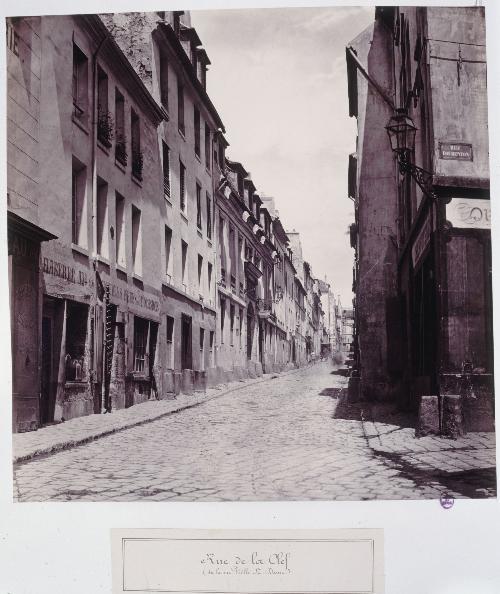
"then the Fountain Saint-Victor, skirted the Jardin des Plantes by the lower streets, and reached the quay. There he turned round. The quay was deserted. The streets were deserted. There was no one behind him. He drew a long breath.
He gained the Pont d’Austerlitz." (The Pont d'Austerlitz, named after Napoleon's victory at the battle of Austerlitz, is a very famous bridge. Marville has no photographs but here's an 1830 engraving:)

"The bridge once crossed, he perceived some timber-yards on his right. He directed his course thither. In order to reach them, it was necessary to risk himself in a tolerably large unsheltered and illuminated space. He did not hesitate. Those who were on his track had evidently lost the scent, and Jean Valjean believed himself to be out of danger. Hunted, yes; followed, no." Here's the quai by the pont-au-change-- a different quai, but gives you an idea of what the areas around the Seine often looked like.
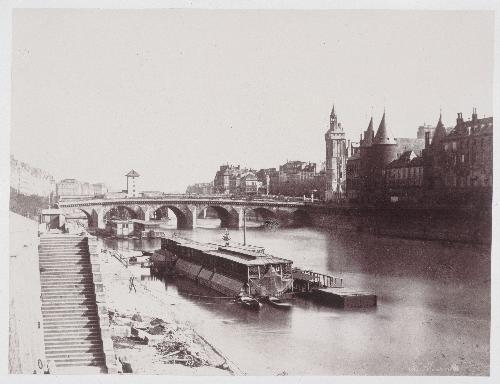
(Then Jean Valjean sees Javert and the other police on the Bridge of Austerlitz, following him. He hurries towards the darker alleys of the city.)
"A little street, the Rue du Chemin-Vert-Saint-Antoine, opened out between two timber-yards enclosed in walls. This street was dark and narrow and seemed made expressly for him."
Here's an abandoned timber-yard-ish looking picture:

But Marville has no photographs of this street. I'd have to double check, but iirc this is the part where Hugo starts to 'make up' more street layouts. I wouldn't be surprised if this street really WAS made expressly for him (meaning Hugo made it up.) "The point of Paris where Jean Valjean found himself, situated between the Faubourg Saint-Antoine and la Râpée, is one of those which recent improvements have transformed from top to bottom,—resulting in disfigurement according to some, and in a transfiguration according to others. The market-gardens, the timber-yards, and the old buildings have been effaced. To-day, there are brand-new, wide streets, arenas, circuses, hippodromes, railway stations, and a prison, Mazas, there; progress, as the reader sees, with its antidote."
(Here Hugo talks about the Haussman renovations directly, claiming that if his street layouts are "inaccurate" it's because these are some of the Old Medieval Streets that were razed during Paris's recent renovations. He goes on for a while comparing Petit-Picpus to various other areas that were changed during the renovations.)
"Le Petit-Picpus, which, moreover, hardly ever had any existence, and never was more than the outline of a quarter, had nearly the monkish aspect of a Spanish town. The roads were not much paved; the streets were not much built up. (....) Such was this quarter in the last century. The Revolution snubbed it soundly. The republican government demolished and cut through it. Rubbish shoots were established there. Thirty years ago, this quarter was disappearing under the erasing process of new buildings. To-day, it has been utterly blotted out."
The Petit-Picpus, of which no existing plan has preserved a trace, is indicated with sufficient clearness in the plan of 1727, published at Paris by Denis Thierry, Rue Saint-Jacques, opposite the Rue du Plâtre;

and at Lyons, by Jean Girin, Rue Mercière, at the sign of Prudence.
Petit-Picpus had, as we have just mentioned, a Y of streets, formed by the Rue du Chemin-Vert-Saint-Antoine, which spread out in two branches, taking on the left the name of Little Picpus Street, and on the right the name of the Rue Polonceau. The two limbs of the Y were connected at the apex as by a bar; this bar was called Rue Droit-Mur.
The Rue Polonceau ended there; Rue Petit-Picpus passed on, and ascended towards the Lenoir market. A person coming from the Seine reached the extremity of the Rue Polonceau, and had on his right the Rue Droit-Mur, turning abruptly at a right angle, in front of him the wall of that street, and on his right a truncated prolongation of the Rue Droit-Mur, which had no issue and was called the Cul-de-Sac Genrot." Here is @everyonewasabird's attempt to puzzle this out:

It was here that Jean Valjean stood."
Then Jean Valjean escapes by pulling down an old oil lantern, strung up by ropes. Hugo notes that this would have been "impossible if the streets were lit with gas, the way they would be after the renovations. This picture shows an old oil lamp strung up by ropes:

Finally, Jean Valjean climbs over the wall into the Petit-Picpus convent. This convent is fictional. Hugo pretends it used to exists but is no longer around-- another relic of the early 19th century that has been lost over time.
TLDR:
Jean Valjean's escape through Paris is Hugo way of mourning the Paris he knew from before his exile, the Paris before the modern renovations. To quote Volume 2 Book 5 Chapter 1:
The author of this book, who regrets the necessity of mentioning himself, has been absent from Paris for many years. Paris has been transformed since he quitted it. A new city has arisen, which is, after a fashion, unknown to him. There is no need for him to say that he loves Paris: Paris is his mind’s natal city. In consequence of demolitions and reconstructions, the Paris of his youth, that Paris which he bore away religiously in his memory, is now a Paris of days gone by. He must be permitted to speak of that Paris as though it still existed. It is possible that when the author conducts his readers to a spot and says, “In such a street there stands such and such a house,” neither street nor house will any longer exist in that locality. Readers may verify the facts if they care to take the trouble. For his own part, he is unacquainted with the new Paris, and he writes with the old Paris before his eyes in an illusion which is precious to him. It is a delight to him to dream that there still lingers behind him something of that which he beheld when he was in his own country, and that all has not vanished. So long as you go and come in your native land, you imagine that those streets are a matter of indifference to you; that those windows, those roofs, and those doors are nothing to you; that those walls are strangers to you; that those trees are merely the first encountered haphazard; that those houses, which you do not enter, are useless to you; that the pavements which you tread are merely stones. Later on, when you are no longer there, you perceive that the streets are dear to you; that you miss those roofs, those doors; and that those walls are necessary to you, those trees are well beloved by you; that you entered those houses which you never entered, every day, and that you have left a part of your heart, of your blood, of your soul, in those pavements. All those places which you no longer behold, which you may never behold again, perchance, and whose memory you have cherished, take on a melancholy charm, recur to your mind with the melancholy of an apparition, make the holy land visible to you, and are, so to speak, the very form of France, and you love them; and you call them up as they are, as they were, and you persist in this, and you will submit to no change: for you are attached to the figure of your fatherland as to the face of your mother.
185 notes
·
View notes
Text

Les Grandes Serres du Jardin des Plantes à Paris, France 1937. Conçu par René Berger (1878-1954) (Courtesy: Jungalow® by Justina Blakeney on Pinterest; @seeinberlin). - source Sally Jo via Art Deco.
235 notes
·
View notes
Text

Jardin🌷✨ - I've been working on this big plant illustration to turn it into a wide desk mat, I'm so happy with how it turned out ! While I'm searching for the right supplier, it's already available as HD screen wallpaper on my Patreon page 💖 . J'ai enfin fini cette grande illu sur laquelle je travaillais depuis quelques temps, en vue d'en faire un grand tapis de souris ! Je suis encore à la recherche d'un bon fournisseur pour la production du tapis, mais vous pouvez déjà télécharger l'image en fond d'écran HD sur ma page Patreon!💖
117 notes
·
View notes
Text
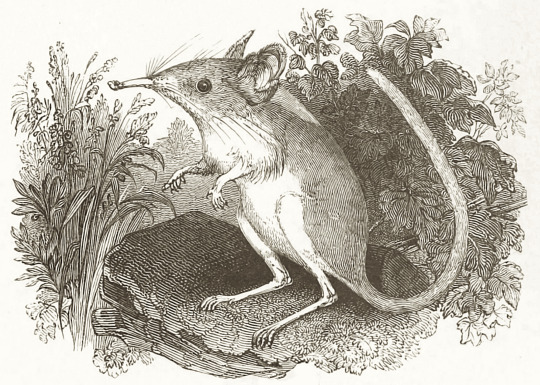
Le Jardin des plantes : description complète, historique et pittoresque du Museum d'histoire naturelle, de la ménagerie, des serres, des galeries de minéralogie et d'anatomie et de la vallée suisse - c.1842-1843 - via Gallica
146 notes
·
View notes
Text
A new community garden was inaugurated in Montreal’s Chinatown. A first of its kind in Quebec, the Kahéhtaien Jardin Lumb hosts both Asian and Indigenous plants and aims to connect different communities. “These are two ancient cultures coming together,” explained Leslie Cheung, board of directors president of the Montreal Chinatown Round Table. The initiative was born out of a partnership between the Chinatown Round Table and Projets Autochtones du Quebec. One of the garden’s purposes is to offer a space to Chinatown residents and unhoused people in the area to meet each other. This comes at a time where tensions between the two groups are rising. The garden would offer another way for to learn about each other.
Continue Reading
Tagging: @newsfromstolenland
71 notes
·
View notes
Text
you should read about this experiment from 2009 it's so funny
there's this argument that classifying animals as endangered paradoxically hurts them bc interest and demand surge when things are perceived to be rare. the people behind this article were like "well can we even prove that's true of the general population" so they set up a series of tricks at la ménagerie du jardin des plantes in paris to see what people would be willing to do to see rare species compared to common ones


the first experiment was just measuring time spent in front of a terrarium of frogs labeled rare vs frogs labeled common when all the frogs were similar in appearance. but then they moved on to dastardly schemes such as labeling empty terrariums as having "rare" or "common" animals and watching how long people spent looking for the non-existent animal, seeing how many floors people were willing to climb if signs indicated a rare animal was several floors up, and even turning on a sprinkler along a pathway leading to a rare animal to see if people would still walk through the sprinkler to see it?!
the grey bar in the chart indicates rare and the white bar is common, so you can see that in almost every case people would put in more effort to see an animal they were led to believe was rare
25 notes
·
View notes
Text

Je ne sais pas pour vous, mais l'amour des plantes m'est venu avec l'âge. Depuis 3 ans, mon salon, ma chambre, le bureau, la salle de bain et bien entendu mon balcon, se sont transformés en jardin. Moi qui n'avais pas la main verte, je suis désormais une excellente jardinière ! Probablement, mon besoin d'apporter de l'attention et du soin s'est rabattu sur les plantes et les animaux quand les enfants ont quittés la maison.
41 notes
·
View notes
Text

Le temps d'une balade sous la pluie...
Les petits pieds en randonnée et entendre le son de la pluie tomber sur notre parapluie, a un effet si relaxant, qu'il nous fait d'autant plus apprécier l'instant présent de cette balade pluvieuse. Tout en marchant, on respire les odeurs des arbres et des plantes qui sont bien plus marquées. On sent également la terre mouillée et le parfum si particulier du sous-bois. L'air frais touche délicatement notre visage, nous mettons de côté notre parapluie, pour laisser l'eau mouiller notre figure, et nous ouvrons la bouche pour happer chaque goutte de pluie. Nous laissons notre enfant intérieur jouir de ce moment, et goûtons au bonheur simple mais intense des jolies choses de la vie !
#au-jardin-de-mon-coeur ✒️
17 notes
·
View notes
Text
Il y a un chat qui nous a adoptés. Je le connais depuis quelques mois, il allait de jardin en jardin à la fin de l'été, maigre et craintif. Je lui donnais à manger quand je le voyais et il attendait que je sois partie pour manger. Craintif à ce point. Je le surnomme kangourou pcq je voyais son petit corps sauter par dessus les hautes herbes.
Depuis une semaine ce petit bonhomme se plante à une fenêtre et attire l'attention d'Oreo et Muffin jusqu'à ce que j'arrive, et sorte lui donner des croquettes.
Mardi, prévoyant peut-être la neige (?), il était sur le châssis de la porte, et y est revenu après avoir mangé les croquettes.
Puis demande clairement pour rentrer.
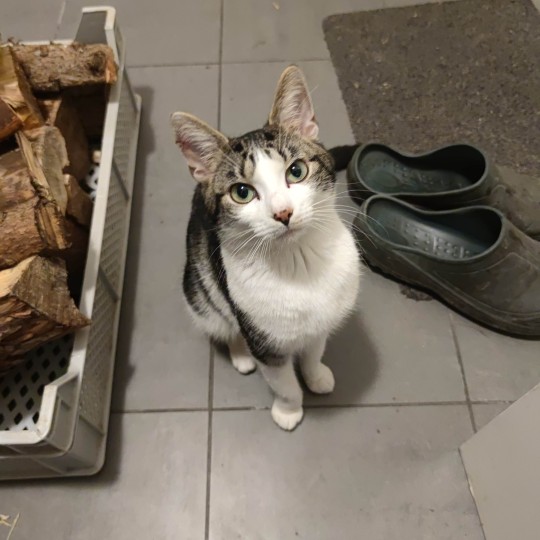
(mardi dans l'entrée de la maison)
Mais bon j'ai déjà deux chats, il a reçu un coussin top confort, une litière propre, de l'eau de spa au cas où ses reins sont fragiles des croquettes, et un toit vu qu'il a dormi dans les toilettes.
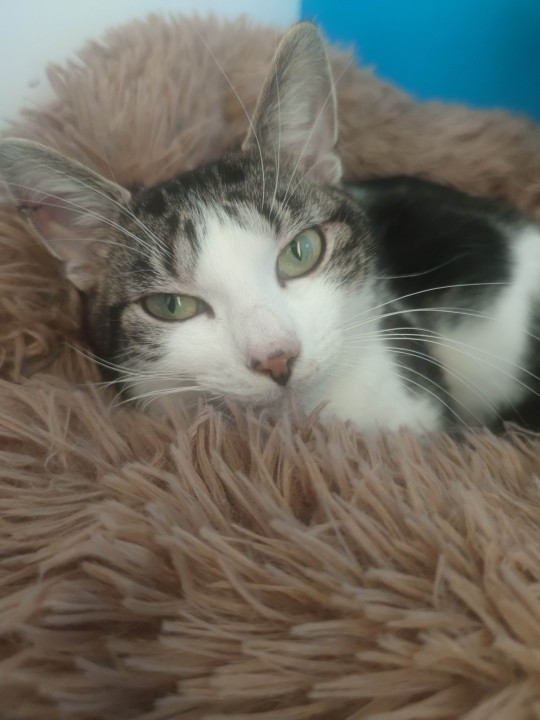
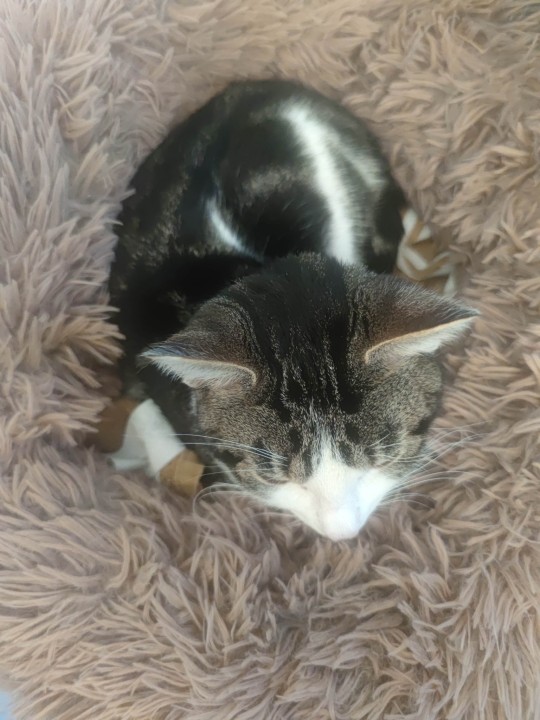
Mercredi avant la neige je suis allée acheter de l'anti-puces. Puis je suis allée le voir régulièrement. Moins craintif du coup.
Et bon tout à l'heure nous bravons le verglas et allons chez le vétérinaire pour voir s'il n'a pas de maladies qui pourraient être transmises à mes chats, voir s'il est pucé (please, non 🥺 j'ai pas envie de devoir le rendre) Là pour l'instant on est en mode câlins et Oreo et Muffin le jaugent de loin.
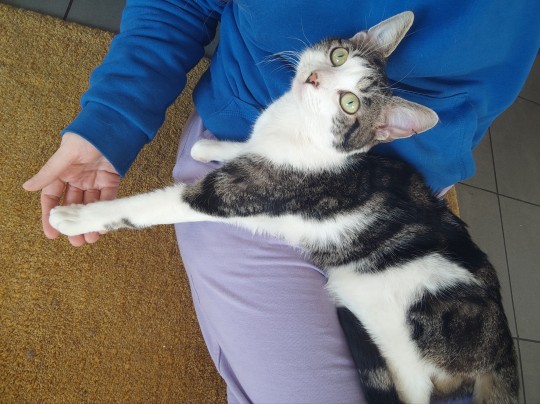
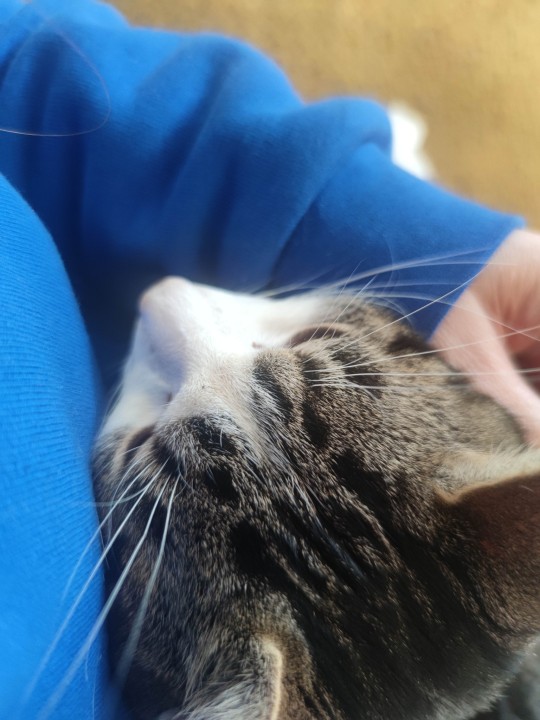
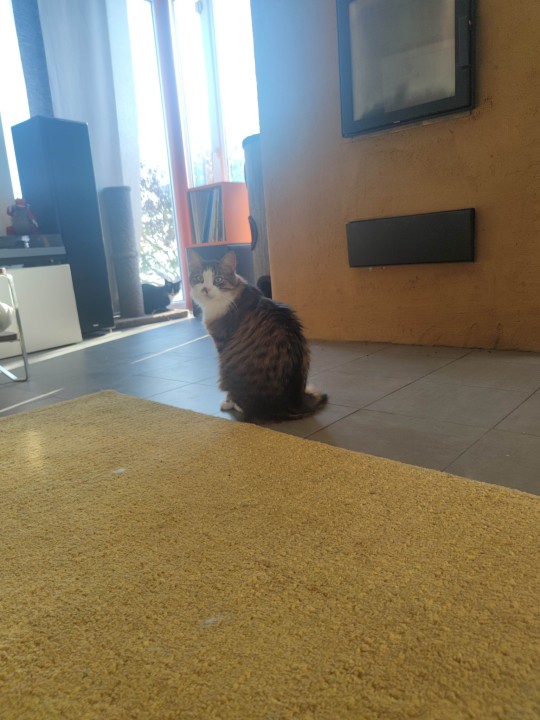

79 notes
·
View notes
Text
📍Nice,French Riviera,France 🇫🇷
Here's why it should be at the top of your list!
Things to do in Nice:
Promenade des Anglais – Stroll along the famous seaside boulevard.
Old Town (Vieux Nice) – Explore the narrow streets and colourful markets.
Castle Hill (Colline du Château) Enjoy panoramic views of Nice and its surroundings.
Marc Chagall National Museum Discover the works of the famous artist.
Place Masséna – Visit the central square with beautiful architecture.
Cours Saleya Market - Experience the bustling flower and food market.
Port Lympia – Wander around the picturesque harbour.
Parc Phoenix - Relax in the botanical garden with exotic plants and animals.
Mont Boron – Hike for stunning views of Nice and the Mediterranean.
Lunch at Le Plongeoir.
🚗Day-Trips from Nice:
1. Monaco:
Just a short train ride away, Monaco offers glitz and glamour with its famous casino, the opulent Monte Carlo district, and the Prince's Palace.
2. Cannes:
Known for its international film festival, Cannes boasts lovely beaches, a charming old town, and a glamorous waterfront promenade, La Croisette. 30 minutes by🚊
3. Antibes:
Antibes is known for its old town enclosed by 16th-century ramparts, the Picasso Museum housed in the Château Grimaldi, and the luxury yacht-filled Port Vauban. 20 minutes by🚊
4. Eze:
A mediaeval village perched high on a cliff above the Mediterranean, Eze offers stunning views, quaint streets, and the exquisite Jardin Exotique. Accessible by a short bus or train ride followed by a hike or a local bus up to
the village.
5. Saint-Paul de Vence:
This famous art village is known for its art galleries, picturesque streets, and historical charm. 45 minutes🚗
6. Menton:
Often referred to as the "Pearl of France". 40 minutes by.🚊
7. Villefranche-sur-Mer:
A charming coastal town known for its picturesque old town, vibrant harbour, and stunning beaches. 15 minutes by.🚊
🎥@zenwander
#visitnice #frenchrivieraplaces
#traveleurope #voyaged
#frenchriviera #southoffrance
#travelfrance #cotedazur
#frenchrivieralife #frenchsummer
#summereurope
#beautifuldestinations
Bonjour France 🇫🇷
24 notes
·
View notes
Text

TW — drogue inventée (légère mention), oppressions (mention).
LES CATACOMBES
Il y a eu la cruauté, les discriminations ; et devant la haine, on s'est organisé là où on ne nous trouvera pas. Les communes altérées se construisent comme des oasis, cachés des non-altéré·es, où on peut vivre en paix. La plus connue, Providence, se dresse en cathédrale géante au-dessus du Point Némo. Elles sont, toutes, autogérées ; c'est-à-dire que les altéré·e·s les composant en prennent les décisions ensemble. En France, il en existe deux : une perdue dans les Alpes, l'autre située dans les Catacombes de Paris. Les galeries ne s'ouvrent que pour nous. Les non-altéré·es ont leur partie, on a la notre. Nos catacombes sont aménagées. Il y a des échelles pour les explorer, des appliques au mur pour les éclairer. Sur les carrefours, des pancartes ; mieux vaut quand même y descendre avec quelqu'un qui s'y connaît déjà pour éviter de se faire avaler tout rond.
POINTS NÉVRALGIQUES
C'est comme des lieux de rencontres ; des endroits où les galeries finissent par déboucher. Ils forment des petits villages, avec une bonne hauteur sous plafond, où l'on se sent presque pas sous terre. Certains cultivent même de la végétation ; c'est le cas du Refuge de Bescel.
LA COUR DES MIRACLES Zone de non-droit où on fait la loi. L'endroit où ta mère t'interdit d'y aller. Non, mais ; il y a des petites boutiques sympa à côté des boites de nuit et des bars. La nuit, tout le monde s'y rend pour s'éclater le crâne, se bruler les sinus, se percer les tympans. La journée, tout est fermé : la cour des miracles reste vide jusqu'à la tombée de la nuit, elle se remet de sa gueule de bois. Là-bas, t'y trouves tes meilleurs potes, des gens qui fêtent toutes sortes de choses ; des types recherchées par la loi, en cavale depuis 40 ans. Il y a plein d'histoires qui se racontent là-bas, plein d'histoires qui s'écrivent aussi. C'est aussi le paradis parfait pour l'Érythryle et pour celles et ceux qu'organisent une révolution sans paillettes, mais avec beaucoup d'artifices.
LES THERMES Des galeries inondées ; où l'eau, purifiée et chauffée, permet de s'y baigner. C'est bas de plafond, mais bien éclairé. Des altéré·es y vivent, dans des alvéoles, mais c'est surtout l'endroit où celles et ceux qu'ont besoin de flotte pour respirer peuvent se reposer. On s'organise, comme on peut, pour aller les voir, leur parler ; faire des soirées. On commence à y faire pousser des plantes, à décorer l'endroit, mais ça reste bien sommaire : on en est qu'au début.
LE REFUGE DE BESCEL Le bâtiment, en Art déco, serpente dans les galeries, les ouvrent, les embellit. Il y a une partie à la surface, un dôme de verre pour laisser passer la lumière sur les jardins. Ses bras sont bâtis de vieilles pierres, l'acier se rouille, se fait vieux. Mais il y a un odeur de confort dans la poussière qui s'y repose. À l'intérieur, il ressemble à un orphelinat bloqué dans le temps. Il y a des rires, des pleurs quelques fois, mais tout le monde essaie de rendre l'endroit joli. C'est un effort commun, de toute la communauté, pour qu'il tienne debout. Et putain qu'il est précaire son équilibre. Certain·es altéré·es se la jouent profs, d'autres toubibs ; certains sont payés, travaillent jour et nuit là-dedans, d'autres viennent lorsqu'iels ont le temps. Ça arrive que des gens malintentionnés essaient de s'en prendre à la bâtisse. Et pour ça, t'as des types de la Cour des Miracles qui en assurent sa protection.
Il y a beaucoup d'animaux dans le refuge : des chats et des chiens, surtout. Le Refuge de Bescel a un partenariat avec la SPA. Les cabots aident souvent les altéré·es, il est pas rare d'en dresser certains pour qu'ils deviennent de véritables alliés. Les chats, eux, permettent à certains pensionnaires de trouver un peu de calme. Ça apporte un soutien, de la vie et un peu de réconfort.
À NOTER : Pour les altéré·es handi·es, on a creusé des galeries pour elleux. Elles sont sans échelles, avec des pentes plus abordables et des aides pour s'y déplacer. Si ça reste trop compliqué, on s'organise. Il y a des altéré·es spécialement formé·es à descendre celles et ceux qui peuvent pas le faire seul·es. Ça s'organise entre les concerné·es, c'est plutôt bien foutu et c'est dans l'écoute du respect et des besoins de chacun.
#projet forum#projet rpg#forumactif#rpg city#rpg fantastique#rpg forum#rpg francophone#rpg faceclaim
15 notes
·
View notes